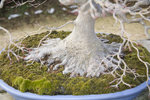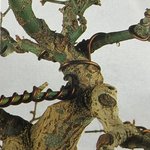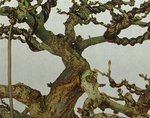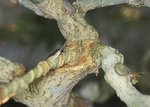The results have been duplicated nearly 100 times in Ebihara's garden. At least one tree built by Ebihara was submitted to Kokufu this year. We'll find out this weekend if it was accepted.
Unfortunately, it takes roughly 15-20 years to 'complete' the process. That amount of time is fundamental part of the recipe, and is just as important as any aspect of the physical techniques. This thread started in 2015, so you're not going to find 'duplication' here for another 10-15 years, but you can speak to former and current apprentices familiar with Kouka-en and Fuyo-en if you want to see duplication outside of Ebihara's garden

I don't want to reveal all of the details from Andrea Meriggioli's book, but the 'choking' that he proposes has multiple purposes. Sure it ramifies the roots, but if applied systematically it also helps control the maximum size that any root can get. It also allows roots to get to the desired size before being choked or pruned. (Ebihara would have managed this with diligent root pruning, instead of with Meriggioli's 'choking').
One notable characteristic of a lot of Ebihara maples is the number of evenly-sized 'fingers' on the perimeter of his nebari, all of which tend to lead back to the trunk (see 3 photos attached). In the picture of the tree you posted, i can see 6 larger roots. I'd say you're missing about 30-40 more of those emerging from around the circumference of the trunk to be doing what Ebihara was doing.
It's easier than you think
-The cambial layers
do not need to line up perfectly all around. Take a look at pictures 4, 5 and 6 attached here. It's
very far from an even match. Maybe it will help to think of what happens when you perform a thread graft without any cambial contact (or cambial contact only on one side).
-The peg doesn't need to be exact. It is cut to approximate size, and then 'cement' is used to hold it in place







